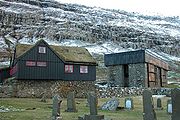Kirkjubøargarður
| Kirkjubøargarður | |
|---|---|
Faroese government | |
| Website | |
| patursson.fo |
Kirkjubøargarður (Faroese for Yard of Kirkjubøur, also known as King's Farm) is one of the oldest still inhabited wooden houses in the world, if not the oldest. The farm itself has always been the largest in the Faroe Islands.
The old
The oldest part is a so-called roykstova (reek parlour, or smoke room). Perhaps it was moved one day, because it does not fit to its foundation. Another ancient room is the loftstovan (loft room). It is supposed that
Though the farmhouse is a museum, the 17th generation of the Patursson family, which has occupied it since 1550, still lives there. Shortly after the
The farm holds sheep, cattle and some horses. It is possible to get a coffee here and buy fresh mutton and beef directly from the farmer. In the winter season there is also hare hunting for the locals. Groups can rent the roykstovan for festivities and will be served original Faroese cuisine.
Other notable buildings near the farmhouse are the Magnus Cathedral and Saint Olav's Church, which also date back to the medieval period.
People
Notable people who were born here or lived here for a period:
- Sverre I of Norway(1151–1202), grew up here and went to the priest school.
- Bishop Erlendur (d. 1308), wrote the Sheep Letter and built the Magnus Cathedral.
- Súsanna Helena Patursson (1864–1916), first feminist of the Faroes.
- King's farmer Jóannes Patursson (1866–1946), oldest brother of Helena, nationalist leader and writer.
- Sverre Patursson (1871–1960) brother of Helena and Jóannes, writer, journalist and environmentalist.
- Erlendur Patursson (1913–1986), son of Jóannes, writer and nationalist politician.
- Tróndur Patursson (born 1944), great-grandson of Jóannes, artist and adventurer.
Images
-
On the left: Kirkjubøargarður; on the right the ruin of Magnus Cathedral
-
The entrance of Roykstovan was destroyed in 1833. This true to original copy was timbered and carved by the King's FarmerNorwegian Lion, indicating that the Faroes were a Norwegian colony after the Viking age.
-
Jóannes Patursson (1866–1946), Faroese politician, poet and farmer
-
Kirkjubøargarður (on the right) during a blizzard
External links
- Kirkjubøargarður official website




